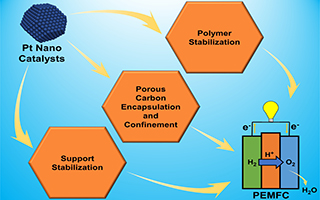质子交换膜燃料电池使用寿命低是制约其商业化应用的主要瓶颈. 其中,影响质子交换膜燃料电池寿命的一个主要因素是其所广泛使用的贵金属铂基电催化剂在燃料电池苛刻的运行环境下(如可变电压、强酸性、气液两相流等)容易发生降解,导致电催化剂性能衰减,从而降低了质子交换膜燃料电池的使用寿命. 因此,如何保持铂基电催化剂的电化学稳定性已成为质子交换膜燃料电池稳定性研究中的重大科学问题. 本论文基于作者在该领域的长期研究成果,评述了应用于质子交换膜燃料电池的铂电催化剂稳定性的研究进展. 重点关注了能够大幅改善铂催化剂电化学稳定性的策略,包括聚合物稳定策略、多孔碳封装/限域稳定策略以及载体稳定策略,并对这些铂催化剂稳定策略所面临的挑战进行了展望.
The low service lifetime of proton exchange membrane fuel cells (PEMFCs) is the main bottleneck for their commercial applications. One of the main factors is that the expensive metal Pt catalyst is easy to degradation under the harsh working environment of PEMFC (such as variable voltage, strong acidity, gas-liquid two-phase flow), which leads to the inevitable decay of the catalytic performance, thus, seriously restricting the lifetime of PEMFC. Therefore, the electrochemical stability of Pt-based electrocatalysts has become an important and hot topic to improve the PEMFC lifetime. In this paper, we review the recent development in enhancing the stability of Pt electrocatalysts for PEMFC, mainly focusing on the achievements obtained by our group, especially, the polymer stabilization strategy, carbon encapsulation/confinement stabilization strategy, and support stabilization strategy. In addition, the challenges in these Pt catalyst stabilization strategies are summarized, and the corresponding measures and future research trends in facing these challenges are suggested.




